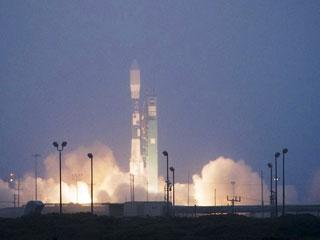
A Delta 2 rocket launches with the Aquarius/SAC-D spacecraft payload from Space Launch Complex 2 at Vandenberg Air Force Base, Calif. on June 10, 2011. Photo:NASA
WASHINGTON (AFP): The US space agency on Friday has launched a satellite to observe levels of salt on the surface of the world's oceans and measure how changes in salinity may be linked to future climate.
The Aquarius/SAC-D spacecraft launched from Vandenberg Air Force Base in California at 7:20 am Pacific time (1950 IST).
The orbiting science instrument will aim to map the entire open ocean every seven days from its position 408 miles (657 kilometers) above Earth, producing monthly estimates that show how salt levels change over time and location.
"The mission will survey the salinity levels at the surface of the ocean and seas and will complete the most detailed summary of conditions ever undertaken," NASA said.
"Until Aquarius, salt-content observations were mostly taken by ships traversing their trade routes. The information was incomplete, researchers say."
The mission to survey the world's water surfaces is set to last for three years.
The name of the mission refers to US-Argentine Aquarius Satellite de Aplicaciones Cientificas (SAC)-D observatory.
A European satellite was launched in 2009 to measure soil moisture and ocean salinity.
The European Space Agency's Soil Moisture and Ocean Salinity (SMOS) mission's main focus is soil moisture, while Aquarius is aimed primarily at measuring ocean salinity, which plays a key role in exchanges of water and heat in the atmosphere.
 Previous Article
Previous Article Next Article
Next Article













The Indian Air Force, in its flight trials evaluation report submitted before the Defence Ministry l..
view articleAn insight into the Medium Multi-Role Combat Aircraft competition...
view articleSky enthusiasts can now spot the International Space Station (ISS) commanded by Indian-American astr..
view article